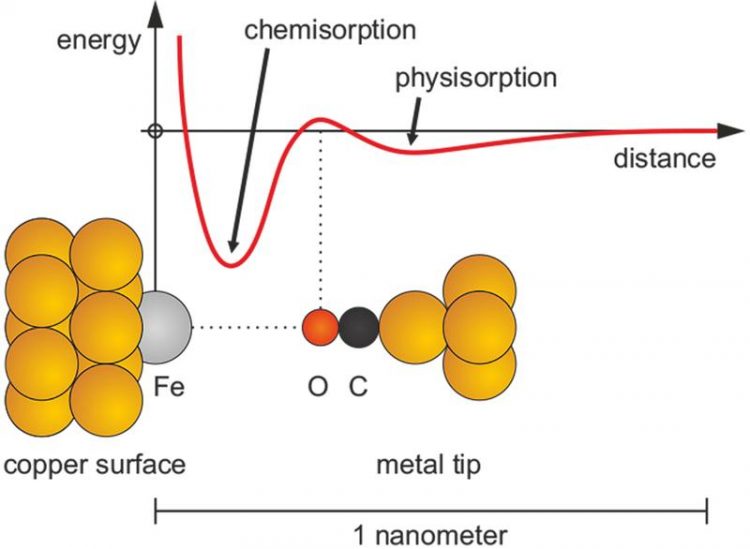Initial repulsion does not rule out subsequent attraction

Transition from a weak physical bond (physisorption) to a strong chemical bond (chemisorption). © Dr. Ferdinand Huber
The Philosopher Arthur Schopenhauer formulated a metaphor called the porcupine dilemma, which explains a certain optimal distance between people. People feel alone at too large a spacing and uneasy at too close a proximity.
Schopenhauer explained the ideal spacing using the following parable: „A number of porcupines huddled together for warmth on a cold day in winter; but, as they began to prick one another with their quills, they were obliged to disperse. However the cold drove them together again, when just the same thing happened.
At last, after many turns of huddling and dispersing, they discovered that they would be best off by remaining at a little distance from one another. In the same way the need of society drives the human porcupines together, only to be mutually repelled by the many prickly and disagreeable qualities of their nature.“ [Wikipedia]
The Physics Nobel laureate Richard Feynman reported a similar phenomenon for the very basic building blocks of matter, the atoms. His three-volume textbook „The Feynman Lectures on Physics“ starts with the presumption that in the case of some cataclysmic event eroding all human knowledge, the following sentence would contain the most useful information about nature in the shortest form: “ …all things are made of atoms – little particles that move around in perpetual motion, attracting each other when they are a little distance apart, but repelling upon being squeezed into one another”. [Feynman Lectures on Physics, Vol. I, 1-2]
However, the nature of the interaction of atoms and molecules with surfaces is even more complex as was already found by the physicist Lenard-Jones back in 1932. In some cases, two modes of bonding can occur: a weak bonding, called physisorption and a strong bonding, called chemisorption. Physisorption makes dust stick to surfaces or allows geckos to walk on walls and ceilings without falling off. Chemisorption is ten to one hundred times stronger than physisorption.
The interplay between physisorption and chemisorption is crucial for the cleaning of exhaust gas in catalytic converters of cars and in industrial reactors that build basic chemicals by catalytic reactions. The two modes of adsorption are expressed by an energy curve that shows two minima. Those energy curves have been displayed in textbooks of physical chemistry and surface science for decades, although experimental access had been limited to the equilibrium points where physisorption and chemisorption occur.
A group of experimental physicists from the University of Regensburg (Ferdinand Huber, Julian Berwanger, Franz J. Giessibl) have been able to experimentally record the genesis of the energy curve that is involved in the transition from physisorption to chemisorption. They achieved this by attaching a CO molecule to the tip of an atomic force microscope and moving it towards a single iron atom that sits on a copper surface while recording the force that acted in the process.
The team included quantum chemists (Svitlana Polyesa, Sergiy Mankovsky, Hubert Ebert) from the Ludwig-Maximilians-Universitity Munich, who worked out the theoretical explanation. Overcoming the energetic barrier between physisorption and chemisorption requires a rearrangement of the electrons (hybridization) that make up the bonds as has been confirmed in the quantum chemical calculations.
Returning to Schopenhauer and human relationships, it is not unheard of that humans can also become highly attracted after overcoming possible initial repulsion.
Prof. Dr. Franz Gießibl
Lehrstuhl für Experimentelle und Angewandte Physik
Universität Regensburg
Tel.: 0941 943-2105
E-Mail: franz.giessibl@ur.de
Ferdinand Huber, Julian Berwanger, Svitlana Polesya, Sergiy Mankovsky, Hubert Ebert, Franz J. Giessibl, “Chemical Bond Formation Showing a Transition from Physisorption to Chemisorption “, Science (2019).
DOI: 10.1126/science.aay3444
Media Contact
More Information:
http://www.uni-regensburg.de/All latest news from the category: Physics and Astronomy
This area deals with the fundamental laws and building blocks of nature and how they interact, the properties and the behavior of matter, and research into space and time and their structures.
innovations-report provides in-depth reports and articles on subjects such as astrophysics, laser technologies, nuclear, quantum, particle and solid-state physics, nanotechnologies, planetary research and findings (Mars, Venus) and developments related to the Hubble Telescope.
Newest articles

Combatting disruptive ‘noise’ in quantum communication
In a significant milestone for quantum communication technology, an experiment has demonstrated how networks can be leveraged to combat disruptive ‘noise’ in quantum communications. The international effort led by researchers…

Stretchable quantum dot display
Intrinsically stretchable quantum dot-based light-emitting diodes achieved record-breaking performance. A team of South Korean scientists led by Professor KIM Dae-Hyeong of the Center for Nanoparticle Research within the Institute for…

Internet can achieve quantum speed with light saved as sound
Researchers at the University of Copenhagen’s Niels Bohr Institute have developed a new way to create quantum memory: A small drum can store data sent with light in its sonic…





















